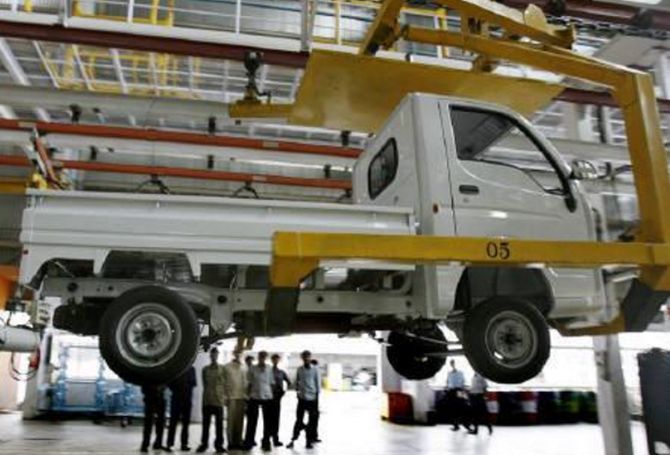Infrastructure, stricter implementation boost commercial vehicle sales

Recovery in the economy, greater infrastructure spending and stricter implementation of overloading norms have boosted sales, say makers of commercial vehicles (CVs).
After years of sluggish growth, there has been a steady uptick in these sales over recent months.
At the aggregate level, sales grew 33.6 per cent in the December quarter of 2017-18, up from 21 per cent in the September quarter.
In January alone, the segment grew a robust 39.7 per cent.
Both light CVs and the medium and heavy ones (M&HCVs) saw strong growth.
Sale of M&HCVs grew 42 per cent in the December quarter, up from 20 per cent in the September one.
In January, they grew 18.8 per cent. Those of LCVs grew 58.3 per cent in January.
In the December quarter, they rose 28 per cent, up from 21.5 per cent in the September quarter.
Those Business Standard spoke to attribute this spike to a multitude of factors.
Economic activity in India has picked up as the effects of the twin shocks of demonetisation and the Goods and Service Tax (GST) fade, boosting demand for CVs.
Gross value added (GVA) growth had plummeted to a low of 5.6 per cent in the first quarter (April-June) of 2017-18 as companies prepared for rollout of GST; manufacturing contracted 1.8 per cent and mining grew a mere 1.8 per cent.
Subsequently, economic activity has picked up, with GVA growing 6.2 per cent in Q2 and 6.7 per cent in Q3.
Mirroring this trend in the larger economy, sales of M&HCVs had contracted by 31.8 per cent in Q1, bouncing back thereafter to a rise of 20.4 per cent in Q2 and further to 42 per cent in Q3.
A similar trend is observed in the LCV segment, where sales grew only eight per cent in Q1, reviving in subsequent quarters.
Second, industry players and analysts say more of infrastructure spending, especially in roads and mining, is boosting demand for CVs.
One result, says Gopal Mahadevan, chief financial officer at Ashok Leyland, is that the industry “has seen a move from the mid-range to higher tonnages - 37 tonner, 41 tonner, 49 tonner”.
Others concur. “Apart from pent demand after GST, growth has been driven by healthy demand for tippers (primarily from the construction sector),” says Subrata Ray, senior group vice-president at ratings agency Icra.
Projects such as Bharatmala are likely to spur this.
Another reason for the sudden spurt in CV demand is stricter implementation of overloading norms by state governments.
“Earlier, trucks were carrying goods far in excess of their capacity. Now, in Uttar Pradesh and Rajasthan, we see stricter implementation of norms. This is leading to a significant increase in demand,” says Ray.
“Major states like UP and Rajasthan and certain parts of Madhya Pradesh have implemented the overloading norms, which has created additional demand for CVs,” says Mahadevan.
“Fleet operators find more loads and, thus, it makes sense to go for a higher tonnage vehicle, as economies of scale start to kick in and the total cost of ownership and profitability is much better in these than in smaller tonnage vehicles like a 20 or 27 tonner.”
Another factor is the rise in demand due to implementation of the BS-IV vehicle emission norms.
With growth up, the outlook for the sector appears bright. Analysts say as the industry saw almost three years of declining sales growth, replacement-led demand is likely to rise.
Second, greater buoyancy expected in consumption-oriented sectors could act as an enabler.
Third, a likely revival in rural demand, which accounts for a significant portion of LCV sales, would also help. Finally, easier financing options could propel sales.
“We have revised our growth estimates for FY18 to 18-20 per cent and expect growth momentum to sustain in FY19, with the segment expected to register a rise of nine to 11 per cent in volume terms,” says Ray.
Photograph: Punit Paranjpe/Reuters











